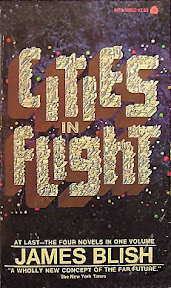 This was originally published as three novellas or short stories: Okie 1950, Bindlestiff 1950, Sargasso of Lost Cities 1953, and Earthman, Come Home 1953.
This was originally published as three novellas or short stories: Okie 1950, Bindlestiff 1950, Sargasso of Lost Cities 1953, and Earthman, Come Home 1953.
In the novel Earthman, Come Home, (not the novella), these shorter works are joined into a story about the Mayor of New York as the city travels between the stars looking for work. The city’s motto is "mow your lawn, lady", which is a little trivial, but Blish is trying to use the metaphor of a migrant worker or Okie to express the nature of the travelling cities. This is an interesting concept, especially since the Bindlestiff is a criminal kind of vagrant that preys on migrant workers.
In the books, the cities are much more than migrant workers and Blish uses the metaphor of bees, pollinating the vastly distributed and varied cultures of earthmen. The book, of course, fails as a novel as there is no larger arc that emerges from the individual stories. Blish tries to make the cities and their culture evolve, but the action in the stories works against him.
Still, the concept is very good. I haven’t read this book in about 20 years, but the imagery of the Hobo Jungle with thousands of cities orbiting a star in a remote section of the galaxy stuck with me and I was glad to reach that part of the story. I was not impressed with how Blish proceeded with this concept, but that snapshot is worth the trip.
The scale is grand due to the size of the cities, the huge number of them, and the long span of years given to the characters. Amalfi, the Mayor of New York, is nearly 1,000 years old at the time of the stories in this book.
The first two stories, Okies and Bindlestiff are basically about the city working on planets that are dangerous and are hard to tell apart. Sargasso of Space is good, where Earthman, Come home is more of a rehash of the basic City gets into trouble and then gets out of it again story.
The book, however, is not a good novel. It is a great anthology. The attempts to smooth over the changes between the four parts do not work to join them together into a larger story. The stories remain stories with a common theme, but there is nothing wrong with that. It is well worth reading and the story "Sargasso of Lost Cities" is one of Blish’s best.
I have a few nits to pick. The major one is that the City of New York includes five boroughs and to get them into a spherical bubble (as the artwork always shows), a large portion of the Hudson River and parts of New Jersey would have to have been included. It appears that the city is actually limited to lower Manhattan from about 42nd street down, unless it is not circular and the whole of Manhattan was included. I wonder if there is a Bronx, Brooklyn or Queens travelling the space lanes. Perhaps Staten Island took off around the year 3,000 with my old Staten Island native roommate Paul at the helm. Other nits are that the anti-aging drugs are in short supply and not given to everyone. I know that no society would last long with these conditions. I think that technology would have found a way to synthesize the drugs, even if they were very expensive and not everyone could afford them. I don’t think that most people would sit around idle in a society where some people were given the drug for free because they were somehow better than the other people. I think Blish glossed over this.